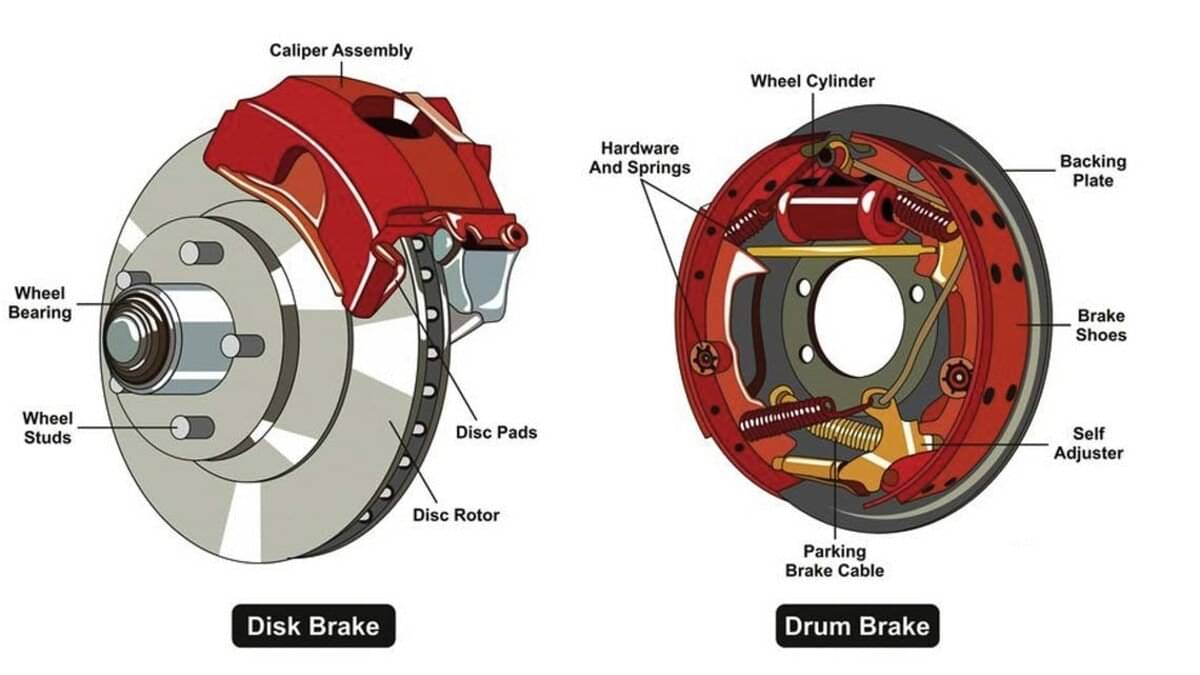Brakes are an important component of every car and we rely on it not only to stop but also help us prevent a potential accident or collision. The car industry has progressed significantly from the early days of woodblock brakes to today’s sophisticated drum and disc brakes. Drum and disc brakes are the two most ubiquitous brake systems that you will find in today’s cars and in many cases, you will find both used on the same car. We explore the advantages and disadvantages of each system to tell you the differences.
Drum Brakes
The first proper brakes on cars were the drum brakes, invented by French manufacturer Louis Renault in 1902. A drum brake consists of a drum, a housing connected to the wheel, brake shoes, which are fitted in the housing and a master cylinder that is connected to the brake pedal. When the brake pedal is pushed the master cylinder causes the brake shoes to rub against the inside of the rotating drum, creating friction and ultimately slowing down the wheel to a complete stop. Drum brakes are used on many mass produced cars and on the rear wheels on more premium car models.
Advantages of Drum Brakes
Durability: Since drum brakes have an increased friction contact area, they last longer.
Low Cost: Drum brakes are cheaper to manufacture, hence they are more widely used on almost all types of vehicles.
Low Input Force: Some drum brakes require low input force to get them activated, meaning less push on the brake pedal, this can be done through various means like hydraulic pressure.
Low maintenance: Due to better corrosion resistance, as they are inside of a housing, they are slightly easier to maintain.
Disadvantages of Drum Brakes
Overheat: Drum brakes tend to overheat in high braking conditions like going down a hill or frequent high speed braking, as they don’t have an outlet to cool themselves down. This causes the brake shoes to glaze or smoothen out and produce no braking action.
Pushing The Brake Pedal Farther: When hard braking occurs, the drum expands slightly due to a phenomenon called thermal expansion. So, to induce braking the driver must press the brake pedal farther.
Grabbing: Grabbing in a drum brake occurs when the brake shoe becomes wet or is slightly rusty. This causes it to offer more braking force than required and stays that way for a brief moment of time. When a grab occurs, the tyres skid and keep on skidding even when the pedal is released. This results in a loss of control of the car and is dangerous for the driver, especially at high speeds.
Complex construction: A drum brake has many components, requiring an expert mechanic for repairs.
Brake Drum
Disc Brakes
Disc brakes were also introduced at the same time as drum brakes, but due to lack of proper technology and higher costs these didn’t take off. The first disc brakes were installed on a car called the Crosley Hot Shot, but then again due to insufficient research and reliability issues these were not popular. However, in 1953, Jaguar used disc brakes on its racing car at the Le Mans 24 hour racing event, and won the race, surprising everyone with its braking capabilities. The disc brakes fitted on the Jaguar racing car outlasted the other cars having drum brakes and thus made its winning debut. Since then disc brakes have been used in mass produced cars.
A disc brake contains a disc or a rotor, a caliper housing the brake pads and a piston. When the brake pedal is pushed, hydraulics force the piston in the caliper to push the brake pad on one side while backward force of the piston is used to pull the brake pad on the other side of the rotor. This produces a squeezing motion which pinches the disc at great force and hence slows or stops the vehicle.
Advantages of Disc Brakes
Less Effort: Due to hydraulics as a standard on all disc brake systems, engaging a disc brake requires less effort and produces greater braking force.
Heat Dissipation: Due to the large surface area of discs any heat produced by friction of the brake pads on the disc dissipates into the atmosphere. This prevents overheating of the disc and improves braking even in frequent hard braking situations.
Standard Performance In Any Weather: Disc brakes perform well even in wet conditions and don’t slip or grab like their drum counterparts.
Easy Installation: A disc brake has a few components and hence very easy to install, even you can learn how to change the brake pads on your discs.
Disadvantages of Disc Brakes
Expensive: Disc brakes are downright expensive and that is the reason why car manufacturers opt for drum brakes on the rear wheels to bring down manufacturing costs.
Rotor Warping: In case of high speed braking there is a chance that the brake rotor might warp. This can happen due to very high temperatures on the discs followed by immediate cooling. Improper installation of the disc brake could also cause it to warp.
Brake Pad Wear Out: Brake pads on disc brakes tend to wear out faster than drum brakes, this happens due to the powerful squeezing motion of the brake piston on the brake pads. This provides better stopping power but reduced brake pad life.
Less Effective As Parking Brakes: The brake pads on discs tend to expand when heated and contract when cold. Since parking does not produce heat, the disc brakes are less likely to hold the wheels for a longer duration. This is the reason why high performance vehicles have an extra drum brake in addition to four wheel discs.




